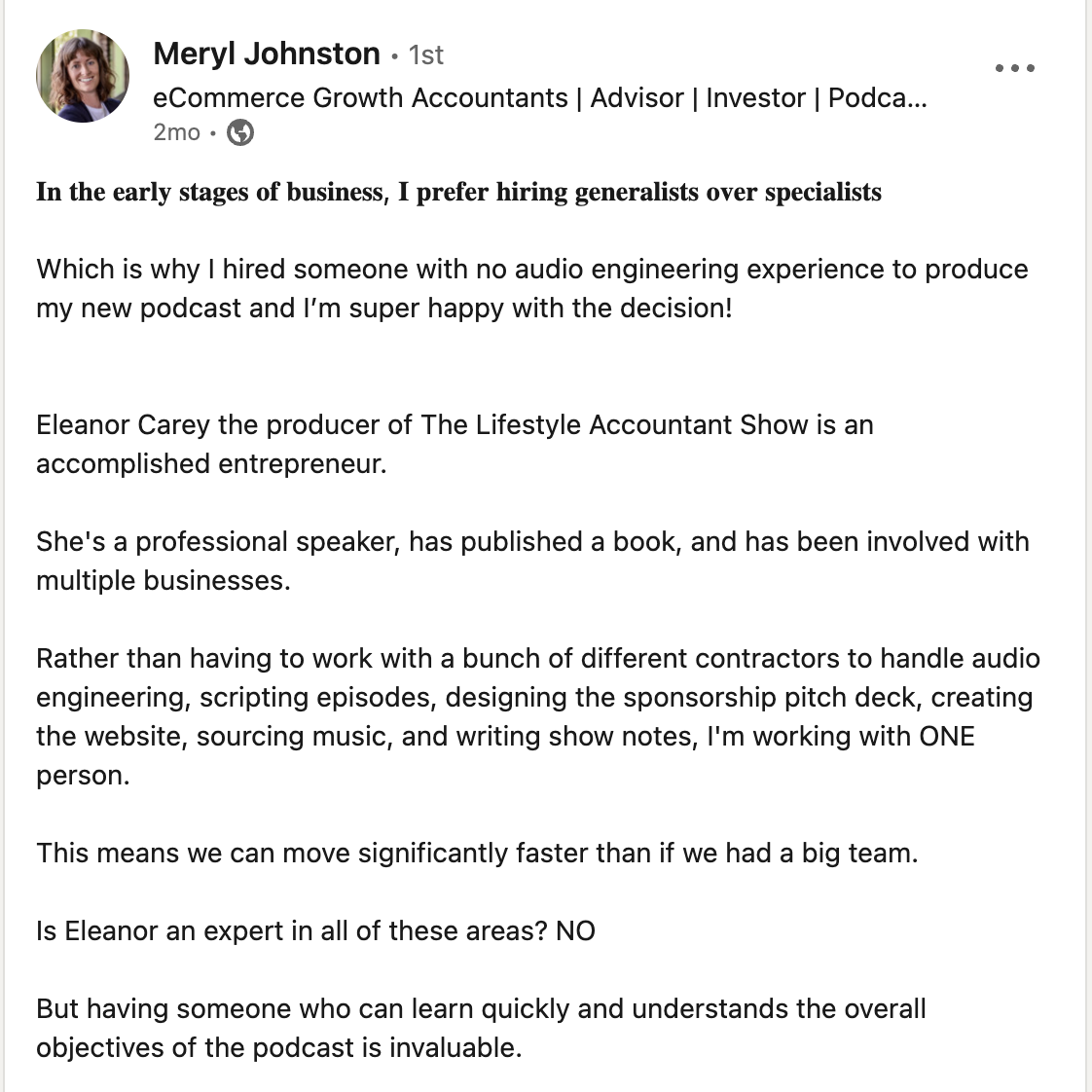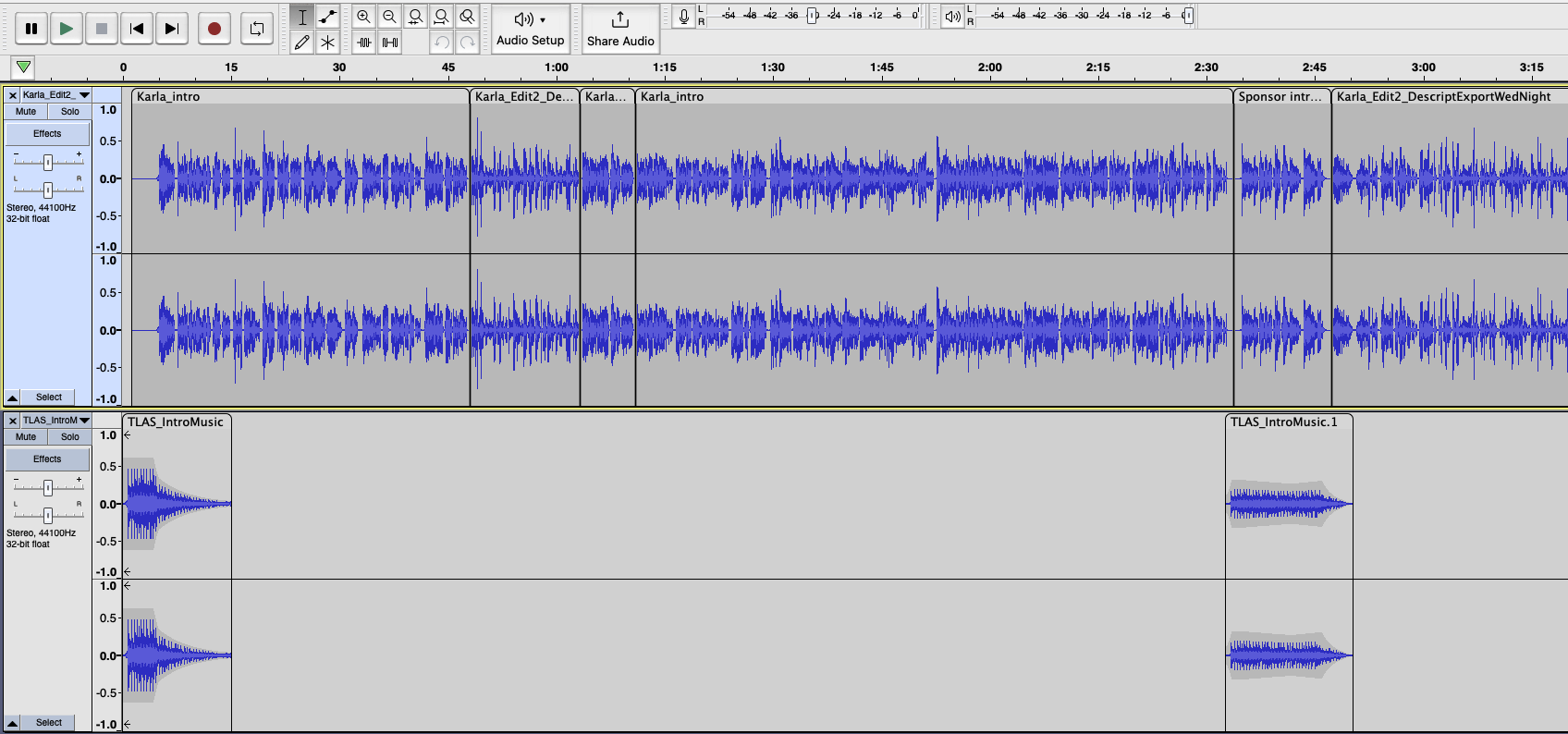🚀How we launched the Lifestyle Accountant Podcast in one month
by Meryl Johnston
In January of this year, I pulled the trigger to start building the Lifestyle Accountant Podcast with the goal of getting the first episode out as soon as possible, while still being able to deliver really high value, quality content to our audience-to-be.
I thought it would be worth sharing the 12 steps we took to move from concept to the launch of the first episode in just over a month:
Step 1: The concept
January 2023
I have always prioritised building a life for both time and financial freedom, but after the health challenges and ups and downs that last year brought - read more about that here - I now feel even more strongly about this for my own life, but also really want others to prioritise themselves too. This is how the concept for the show came about, with the plan being to test the concept with a first season 1, and re-assess from there.
Step 2: Hired a contractor
When it comes to getting things done quickly in order to test the waters and see if it’s a concept worth pursuing, I much prefer to work with generalists who are able to work across a broad spectrum of tasks rather than hiring specialists for each task. I went out to my network to identify someone who was able to think about everything from branding, to scripting episodes, to marketing, to sound engineering and ended up hiring a friend of mine who I had also worked with before, Eleanor Carey. She brought a wide variety of skills to the table including really strong communication, copywriting and editing skills. Eleanor didn’t have experience in the sound engineering space directly, but I knew she had the ability and drive to be able to build those additional skills needed along with the support of some paid mentoring sessions with a podcast producer.
Hiring a generalist is one of the biggest things that enabled us to build the podcast and move so quickly.
Step 3: Chose a name and secured the domain
I had considered a number of different options, from the Balanced Accountant to the Remote Accountant to the Happy Accountant. In the end the naming decision came down to 2 factors: 1. Domain availability and 2. Having a broad enough brand to enable flexibility of content.
With that, The Lifestyle Accountant Show was officially born!
Step 4: Started building interest and asking for feedback by posting on Linkedin
January 2023
I am a big fan of building in public and thoroughly enjoy others’ posts when they include me on their journey, so it only makes complete sense for me to do the same when building the Lifestyle Accountant Podcast! I chose Linkedin as this is my most engaged social platform and this is where I predict the majority of the potential audience will be hanging out.
Step 5: Acquired & created base assets
As the podcast is about prioritising living life to the full, we chose an aqua blue and sand colour as the initial brand colours, and then used Canva to mock up a logo that had the right vibe, but was simple and clean. I spent an hour writing a Storybrand Brandscript and used this as the copy for a one pager website, built on Squarespace.
Of course there are so many options when it comes to building websites that it can be overwhelming to know what to choose, and we had also considered using Webflow. In the end our priority was to move quickly, and as Eleanor was building the website and she had experience with Squarespace that made the most sense to move forward with rather than adding another platform and learning curve to the process. Squarespace also made the job easier as there were pre-created templates specifically for podcasts that we were able to re-brand and run with.
Podcast intro music was selected and purchased for a one off fee of $19USD on Envato, and all social media profiles were claimed for the brand.
Step 6: Getting the podcast setup to publish
Next it was time to start thinking about how the podcast would be published and distributed. There is a long list of podcast hosting platforms. I chose Castos as I have crossed paths with the founder online a few times, and it integrates with all the big players: Apple Podcasts, Amazon, Spotify and Google Podcasts. The best thing about the hosting platform is everything is managed there - from episode uploads, to show notes and artwork - they all get automatically updated everywhere else.
The other decisions to make were which platform to record and edit on. I chose Zencastr for recording as I have used it before so it seemed like the logical choice, and we are going with Descript to edit which looks really user friendly from preliminary use.
Step 7: Invite and schedule interview guests
I was really keen to get people booked in a couple of weeks in advance to ensure their availability, and then to give us enough time to prep the podcast script and interview questions in the back end. We haven’t scheduled all the guests for the first season yet, and will keep running this as a rolling process a couple of weeks in advance to recording each episode:
Step 8: Secure Sponsors for Season 1
February 2023
Another step we took in order to really build credibility and also generate revenue to support the podcast was to seek out sponsors. Once we had a lot of the details sorted as outlined in the previous steps, we created a pitch deck and I sent that out to companies that I thought would be interested and whose values aligned with that of our audience.
It was exciting and heartening to sell out the sponsor slots within the first 24 hours!
Step 9: Work on episode content and questions
Quality is key when it comes to podcasting, so I am made this a priority from the start. I wrote a draft of interview questions for our first guest and then sent them over to Eleanor as the content producer to be edited and expanded upon. We continued the back and forth on this to ensure that the quality was there, before sending a copy to our first interviewee to go over at least 48 hours before recording.
Step 10 - Record, edit and upload
With the first episode under our belt, it was time to go through all the steps to get it ready for publishing. That involved sound editing in Audacity, content editing in an AI driven platform called Descript before scripting and recording the intro and outro for each episode, as well as sponsor ads. The final step is sound mastering, bringing the music and all the different recorded elements together in Audacity again (pictured), checking the levels and exporting it as an mp3 file ready to be uploaded into Castos and distributed out to all the other podcast platforms.
We successfully published the first episode of the podcast - a huge milestone!
Step 11 - Promote
Finally (and arguably one of the most crucial steps of all that never really ends!) is the promotion. We have set up social media profiles across different platforms, but at this stage I have decided to focus on Linkedin as that is where my most engaged network is. As we continue to work on the podcast and expand, we aim to have a consistent social media presence across Twitter and Instagram, and would really like to explore YouTube and TikTok, but we are still ramping up resourcing to be able to fully commit to regular posting.
Step 12: Repeat Steps 6 - 9 for the rest of the season!
Date: February to May 2023
With every episode we learnt a lot and became more efficient in our processes, using a combination of Asana, Slack and Google Docs to manage everything. At the time of publishing, we have 10 episodes live with our final 2 of the first season almost ready to go!
So there we have it - the 12 steps taken to launch a podcast in just over a month!













